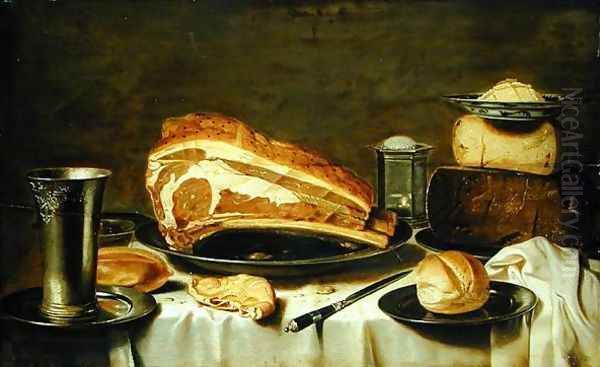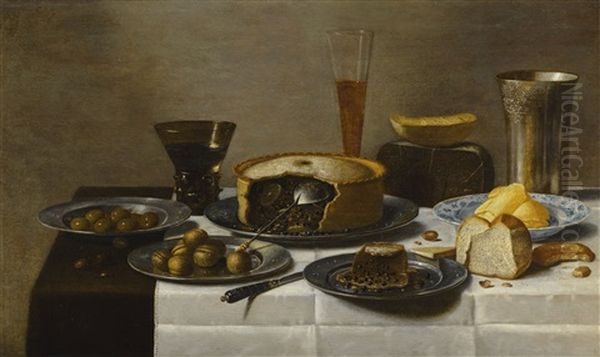Floris Gerritsz. van Schooten stands as a significant figure in the rich tapestry of Dutch Golden Age painting. Active during the 17th century, he dedicated his artistic talents primarily to the genre of still life, becoming particularly renowned for his depictions of kitchen interiors, market scenes, and meticulously arranged tables laden with food. Born around 1585 and passing away sometime after 1655, van Schooten carved a distinct niche for himself within the bustling art scene of Haarlem, a city celebrated for its contributions to still life painting.
It is important at the outset to distinguish Floris Gerritsz. van Schooten, the painter, from his contemporary, Frans van Schooten, who was a notable Dutch mathematician. While sharing a surname and a century, their fields of endeavor were entirely separate, and their life stories unrelated. Our focus here is solely on the artist whose canvases captured the textures, colours, and quiet arrangements of everyday objects with remarkable skill.
The Haarlem Context and Early Influences
Haarlem in the early 17th century was a vibrant centre for artistic innovation, especially in still life painting. Van Schooten emerged during a period when this genre was gaining immense popularity among the increasingly prosperous Dutch merchant class. His work fits within, and contributed significantly to, the Haarlem school's development of still life.
His specific focus on kitchen and market scenes connects him to an earlier tradition pioneered by artists like Pieter Aertsen and his nephew Joachim Beuckelaer in the previous century. These artists often incorporated large-scale still life elements within broader market or kitchen settings, sometimes with biblical scenes in the background. Van Schooten adapted this interest, often reducing the narrative elements to focus more intensely on the arrangements of food and household items themselves, bringing a sense of order and quiet observation to these potentially bustling environments.
Development of a Distinctive Style

Floris van Schooten's style is characterized by its precision and clarity. He possessed a keen eye for detail, rendering the varied textures of cheese, the crust of bread, the gleam of pewter, and the translucence of glassware with convincing realism. His compositions often feature a slightly elevated viewpoint, allowing the viewer a clear overview of the objects arranged across a table or surface. Careful attention was paid to perspective, lending depth and spatial coherence to his scenes.
He worked alongside other prominent Haarlem still life painters who were shaping the genre. Contemporaries such as Floris Claesz. van Dijck and Nicolaes Gillis were also exploring similar themes of laid tables, known as ontbijtjes (breakfast pieces) or banketjes (banquet pieces). Van Schooten, along with these artists and others like the influential Pieter Claesz., helped establish the characteristic features of the Haarlem still life: often relatively simple compositions, a subdued colour palette, and a focus on common foodstuffs and tableware. Sources also suggest he may have been influenced by the work of Pieter Cornelisz. van Rijck.
Over time, some art historians observe a potential shift in his work. While some pieces incorporate figures or suggest broader scenes, many of his most recognized works concentrate purely on the still life arrangement itself. This focus on the inanimate, rendered with clarity and a certain reserved quality, has sometimes been described as having a slightly archaic or simplified feel compared to the more elaborate compositions that developed later in the century, yet it possesses its own distinct charm and strength.
A World on the Table: Subjects and Motifs
Van Schooten’s canvases offer a fascinating glimpse into the Dutch diet and material culture of the 17th century. His most frequent subjects were tables set for a meal, kitchen interiors brimming with provisions, or market stalls displaying produce. These were not necessarily depictions of extravagant luxury, but rather celebrated the abundance and variety of everyday life.
Common motifs recurring in his work include large wheels or wedges of cheese, various types of bread (rolls, loaves), herring, oysters, fruits (grapes, apples, pears, berries), vegetables, butter curls, and an assortment of vessels – pewter plates and jugs, earthenware pitchers, delicate Roemer glasses for wine, and sometimes brass or copper pots. The arrangement of these items is typically orderly, creating a sense of balance and harmony within the composition. He masterfully captured the interplay of light across these different surfaces.

His market and kitchen scenes often present a wider array of goods, sometimes including poultry or larger cuts of meat, alongside vegetables and cooking implements. These works continue the tradition of Aertsen and Beuckelaer but often imbue the scene with a greater sense of stillness and focus on the textures and forms of the objects themselves, rather than the human activity around them.
Layers of Meaning: Symbolism in Still Life
Beyond their surface realism, Dutch still life paintings of this era are often imbued with symbolic meaning, and van Schooten's work is no exception. While interpretations can be complex and debated, certain themes frequently emerge. The depiction of abundant food could serve as a celebration of prosperity and God's blessings, a common sentiment in the Calvinist Dutch Republic.
However, these paintings often carried a moralizing undertone, reflecting the concept of vanitas. This theme served as a reminder of the transience of life and the fleeting nature of earthly pleasures and possessions. Elements within a still life could subtly point towards this: a piece of fruit showing signs of decay, the presence of insects, or even, in some works of the period (though perhaps less explicitly common in van Schooten's known oeuvre compared to others), objects like skulls, hourglasses, or snuffed candles. Even the depiction of a simple meal could act as a prompt to moderation and gratitude for simple provisions, as suggested by interpretations of works like his painting titled Breakfast.
The careful depiction of worldly goods – the food, the fine tableware – could thus simultaneously represent wealth and abundance while also cautioning against excessive attachment to material things. Religious symbolism might also be present; bread and wine, common elements in his breakfast pieces, inevitably carried connotations of the Eucharist for contemporary viewers. Van Schooten's paintings operated on multiple levels, offering visual delight while potentially prompting deeper reflection.
Signature Works
Several paintings stand out as representative of Floris Gerritsz. van Schooten's skill and typical subject matter. His Still Life with Cheese, Herring, Bread and Wine, dated around 1620, is a prime example of his breakfast pieces. It showcases his ability to render different textures convincingly – the crumbly cheese, the oily skin of the herring, the rough crust of the bread, and the reflective surfaces of the pewter plate and glass Roemer. The composition is balanced, the lighting carefully managed to highlight key elements.

Another notable work is his Still Life with Bread, Cheese, Butter, and Buns, from circa 1625. Again, the focus is on a simple yet satisfying arrangement of foodstuffs on a table. The painting demonstrates his mastery in depicting the subtle variations in colour and texture of everyday items, elevating them through careful observation and meticulous execution.
His Kitchen Still Life paintings, such as the one involved in the theft anecdote mentioned later, often present a more complex arrangement of objects within a specific setting. These works demonstrate his ability to handle larger compositions while maintaining his characteristic attention to detail across a wide range of items, from vegetables and meats to various kitchen utensils.
Echoes in Art: Influence and Connections
Floris van Schooten was not an isolated figure but an active participant in the Haarlem art scene, influencing and potentially being influenced by his peers. His approach to the ontbijtje genre had a discernible impact on subsequent artists. Most notably, the early works of the celebrated Haarlem still life painter Willem Claesz. Heda show a clear debt to van Schooten's style and compositional formats. Heda would later develop his own, often more monochromatic and elaborate style, but his beginnings are rooted in the tradition shaped by painters like van Schooten and Floris van Dijck.
The broader context of still life painting in the Low Countries during this period included important figures like Osias Beert the Elder in Antwerp, another pioneer of the breakfast piece, and the remarkable female artist Clara Peeters, whose detailed depictions of food and precious objects share some affinities with the Haarlem school. Later Antwerp painters like Jacob van Es also worked with similar subject matter. While direct collaboration might not always be documented, the shared themes and evolving styles indicate a lively exchange of ideas across different artistic centres.
An intriguing, though perhaps less certain, connection mentioned in some sources suggests that the famous Leiden painter Jan Lievens may have spent some time, possibly very early in his career, associated with van Schooten's studio. While Lievens is primarily known for history painting and portraiture after studying with Pieter Lastman (Rembrandt's teacher), any early exposure to van Schooten's meticulous still life practice would add an interesting dimension to his formative years. This connection warrants careful consideration but highlights van Schooten's position within the network of artists.
A Painting's Journey: Theft and Recovery
Artworks, especially those of historical significance, sometimes have dramatic histories beyond their creation. An interesting anecdote concerning Floris van Schooten involves one of his Kitchen Still Life paintings. This particular work was reportedly stolen from the Westfries Museum in Hoorn, the Netherlands. After disappearing for a number of years, it eventually surfaced in Ukraine. Following investigations and diplomatic efforts, the painting was successfully recovered and returned to the museum. This incident underscores the enduring value placed on works by masters like van Schooten and the complex journeys artworks can undertake through time, sometimes falling victim to crime but occasionally finding their way back home.
Conclusion: Enduring Legacy
Floris Gerritsz. van Schooten was a prolific and highly skilled painter who made a substantial contribution to the development of Dutch Golden Age still life. Working primarily in Haarlem, he excelled in capturing the textures, colours, and forms of everyday objects, particularly food and tableware. His meticulously detailed kitchen scenes, market stalls, and especially his influential breakfast pieces (ontbijtjes) helped define the character of the Haarlem school during the first half of the 17th century.
His work, admired for its realism and compositional clarity, also invites contemplation on themes of abundance, domesticity, and the vanitas tradition prevalent in the era. Through his influence on key figures like Willem Claesz. Heda and his position within a network of talented contemporaries including Floris van Dijck, Pieter Claesz., and Nicolaes Gillis, van Schooten secured his place as an important master whose art continues to engage viewers with its quiet beauty and historical resonance. He remains a testament to the depth and richness of specialization within the Dutch Golden Age.